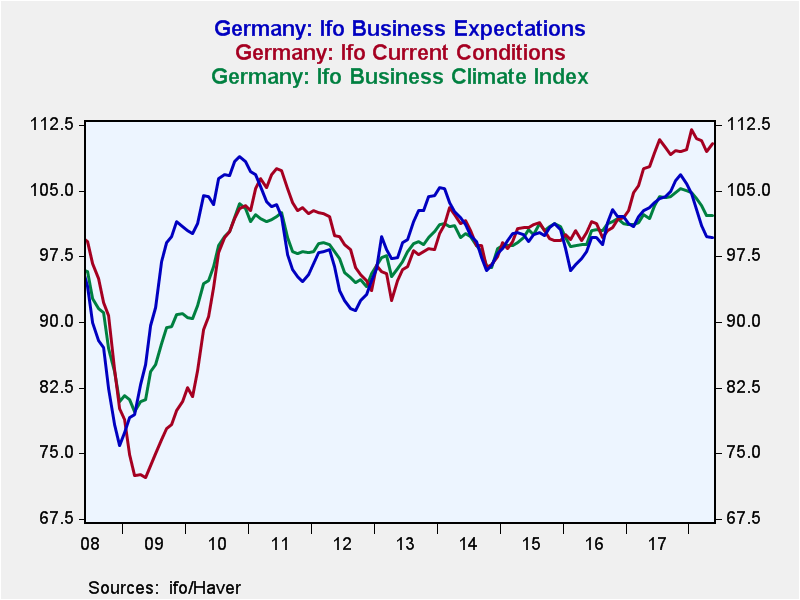 Global| May 25 2018
Global| May 25 2018Step Back for German IFO Gauge
Summary
The IFO business climate gauge fell by 0.5% in May, marking two straight months of decline. However, the current conditions index continued to plow ahead as it has for many months signaling ongoing growth and expansion in the German [...]
 The IFO business climate gauge fell by 0.5% in May, marking two straight months of decline. However, the current conditions index continued to plow ahead as it has for many months signaling ongoing growth and expansion in the German economy. Business expectations fell in May by a sharp 3.4%, marking the third consecutive monthly drop. The expectations drops have been getting larger month by month.
The IFO business climate gauge fell by 0.5% in May, marking two straight months of decline. However, the current conditions index continued to plow ahead as it has for many months signaling ongoing growth and expansion in the German economy. Business expectations fell in May by a sharp 3.4%, marking the third consecutive monthly drop. The expectations drops have been getting larger month by month.
The current situation index resides some 17% above its average while expectations lie only 1.4 percentage points above their average. The rank or queue percentile standings show the climate index at a standing of 93.7%, implying that the index is this high or higher less than 7% of the time. The current situation is this high or higher less than 2% of the time. But business expectations have only a 59.1 percentile standing and are higher than this quite often, about 40% of the time. While the current situation continues to improve, there are growing concerns about the future.

The current situation diffusion index rose in May to 39.9 from 37.8 in April. Expectations slipped from a narrowly positive breadth reading of 2.9 in April to an even narrower 2.6 in May.
We can also rank the diffusion readings. On that score, the all sector climate index is stronger only about 7% of the time. Manufacturing has better breadth about 12% of the time. And the construction sector has this much breadth or better less than 1% of the time- it is quite hot and in fact is at the highest value it has ever logged on this horizon back to 1991. The current situation shows better breadth in expansion only about 1.5% of the time. But expectations show poor breadth as they are better about 40% of the time.
The breadth and strength indicators this month are showing the same picture. Germany’s current situation is doing well and in most cases extremely well. But the outlook is definitely becoming a matter of concern or at least of much less confidence.

Robert Brusca
AuthorMore in Author Profile »Robert A. Brusca is Chief Economist of Fact and Opinion Economics, a consulting firm he founded in Manhattan. He has been an economist on Wall Street for over 25 years. He has visited central banking and large institutional clients in over 30 countries in his career as an economist. Mr. Brusca was a Divisional Research Chief at the Federal Reserve Bank of NY (Chief of the International Financial markets Division), a Fed Watcher at Irving Trust and Chief Economist at Nikko Securities International. He is widely quoted and appears in various media. Mr. Brusca holds an MA and Ph.D. in economics from Michigan State University and a BA in Economics from the University of Michigan. His research pursues his strong interests in non aligned policy economics as well as international economics. FAO Economics’ research targets investors to assist them in making better investment decisions in stocks, bonds and in a variety of international assets. The company does not manage money and has no conflicts in giving economic advice.






